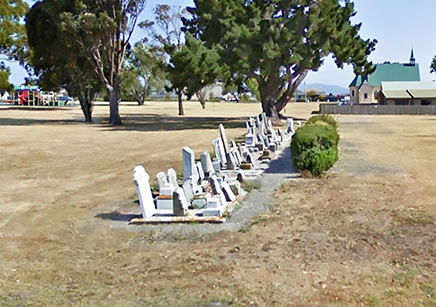
The Williams Family Monument
LES JAMES asks How did it get to Latrobe?

The ADVOCATE newspaper, TASMANIA Photo: Brodie Weeding
The monument stands on the bank of the river Mersey at Latrobe in northern Tasmania and it has always been known as the ‘Atkinson memorial’ in honour of local business man, George Atkinson, “Born May 24 1833 - Died June 21 1920”. His inscription, facing Atkinson park, does not mention that George was born in Yorkshire, England and that at the age of eighteen in 1852, with his mother, he joined his father, George Atkinson, senior, a transportee convicted for burglary.
Closer scrutiny of the photo reveals above the laid wreath on November 4th 2019, the name of the Welsh Chartist leader – Zephaniah Williams (died May 8 1874). Inscriptions on the other two sides commemorate his daughter Rhoda (died March 20 1876), her uncle Edmund (died 25 January 1876) and on the side facing the river, his wife - Joan (died November 22 1863).
Joan died in 1863, her ninth year on the island. In 1854, Zephaniah had been granted a pardon, fourteen years after his shipment from Portsmouth to Port Arthur. And later that year, Joan, arrived aboard the Merlington with daughter Rhoda and brother Edmund and they joined Zephaniah in his mining enterprise at Ballyhoo Creek. Since the Sunday night (3rd November 1839) when Zephaniah led his supporters from the Royal Oak Inn at Blaina to Newport, the couple had endured nearly 15 years of desperate separation.
Rhoda married George Atkinson, junior (24th December 1865). During the 1860s, they crossed the Mersey, making their home and business at the growing settlement of Latrobe and Zephaniah joined them, opening the Don Hotel in 1869.
This stone monument was originally a gravestone erected by Zephaniah for Joan (neé Llewelyn), several miles downriver, in the St. Paul’s (Anglican) cemetery at East Devonport. The wording of her inscription is of a kind that could have only been composed by Zephaniah.
JOAN WILLIAMS
THE BELOVED WIFE OF
ZEPHANIAH WILLIAMS
AND SECOND DAUGHTER OF THE LATE
LLEWELYN LLEWELYN Esq
PENYDERI HOUSE, MONMOUTHSHIRE
SOUTH WALES
WHO DEPARTED THIS LIFE 22nd Nov 1863
AGED 63 YEARS
The monument marked a family vault, where Zephaniah was buried, alongside his one and only wife, over a decade later, and other family members were to follow.
Although he died at Launceston, Zephaniah had lately been living in the Torquay district of East Devonport at the mouth of the Mersey. Atkinson, his son-in-law, had arranged lodgings there for him, whilst he received medical attention.
At his death, Williams was lauded by his fellow pioneers, who celebrated his life as a respected coal entrepreneur and valued member of the rapidly developing settlements, situated around the Mersey estuary.
His peers recognised his success. He had contributed significantly to the island’s make-over from being the notorious ‘hell hole’ of Van Diemen’s Land to its new existence as the colony of Tasmania. They described this long serving ex-con as
“a valuable colonist always endeavouring to develop the mineral resources of the country, and investing all his means towards that end”. (Illustrated Tasmanian News, July 1874)
At his death his son-in-law, was granted Letters of Administration, valuing his estate as “not exceeding £100”. Cannily, Zephaniah had made sure that his and Joan’s ‘winnings’ passed on to his daughter and George. Sadly Rhoda died in 1876, two years after her father, whom she joined at St. Pauls cemetery.
George, left with two young children, invested his inheritance and prospered at Latrobe as a shipper and property developer. From 1877-1916, he ran a successful auctioneering business, which he sold to W. Bell & Company. He had remarried and lived at ‘Frogmore’ House, but he had not forgotten his legacy. He held his in-laws and Rhoda in high regard and at his death, was buried in the Williams vault.
Such was his importance in the development of Latrobe that he served as the first Warden of the Latrobe Council (1908-1913) and in 1936, when the Tourist Association opened a park, it was named after George Atkinson.
The Advocate reported 29 August 1936:
LATROBE. New Park: The newly purchased block of ground near the traffic bridge, which is now the property of the Tourist Association, is receiving attention. Next week the fencing will be commenced, and it is intended to make a rockery and flower plot. It has been decided to call the area the George Atkinson Memorial Park, in honor of the late Mr. George Atkinson, of "Frogmore," who was the first Warden of Latrobe. He took a keen interest in the affairs of the town.
Sophia Atkinson, George’s second wife was buried in 1930 at the Latrobe general cemetery. St. Pauls was closed soon after 1922 and by the 1960s, was suffering vandalism and neglect, with many headstones damaged and smashed. In 1965, the town council decided that both the Anglican and the Wesleyan sites should be landscaped and converted to parkland, named Pioneers Cemetery Park. Surviving headstones were salvaged and re-erected.
 https://www.findagrave.com/cemetery/2444859/east-devonport-pioneer-park-cemetery
https://www.findagrave.com/cemetery/2444859/east-devonport-pioneer-park-cemetery
The Atkinson/Williams monument was moved to Latrobe in 1987
At St Paul’s Cemetery, a plaque was placed:

A.M.D.G.
George Atkinson 1833 - 1920
Zephaniah Williams 1795 - 1874
Joan Williams 1800 - 1863
Rhoda Atkinson 1830 - 1876
Edmund Llewellyn 1802 - 1876
The original monument in memory of the above was transferred to Latrobe in November, 1987 and is now located in Atkinson Park.
M. W. Ford,
Warden, Latrobe Council.
*************
In preparing this article, Les James, is grateful to Sarah Richards for her research assistance. And for the excellent Australian digital sources, available online – notably TROVE (Australian National Library); The Advocate Newspaper, Burnie, Tas; Findagrave.com; Monument Australia.
Also grateful to John Humphries, who first drew our attention to the monument in his book The Man from the Alamo, (2004, pp272-275) and who, in the pre-digital age, had physically visited the monument in person.









